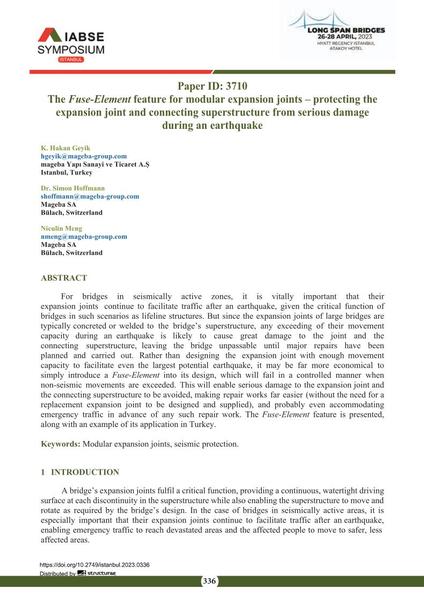The Fuse-Element feature for modular expansion joints – protecting the expansion joint and connecting superstructure from serious damage during an earthquake

|
|
|||||||||||
Détails bibliographiques
| Auteur(s): |
K. Hakan Geyik
(mageba Yapı Sanayi ve Ticaret A.Ş Istanbul, Turkey)
Simon Hoffmann (Mageba SA, Bülach, Switzerland) Niculin Meng (Mageba SA, Bülach, Switzerland) |
||||
|---|---|---|---|---|---|
| Médium: | papier de conférence | ||||
| Langue(s): | anglais | ||||
| Conférence: | IABSE Symposium: Long Span Bridges, Istanbul, Turkey, 26-28 April 2023 | ||||
| Publié dans: | IABSE Symposium Istanbul 2023 | ||||
|
|||||
| Page(s): | 336-343 | ||||
| Nombre total de pages (du PDF): | 8 | ||||
| Année: | 2023 | ||||
| DOI: | 10.2749/istanbul.2023.0336 | ||||
| Abstrait: |
For bridges in seismically active zones, it is vitally important that their expansion joints continue to facilitate traffic after an earthquake, given the critical function of bridges in such scenarios as lifeline structures. But since the expansion joints of large bridges are typically concreted or welded to the bridge’s superstructure, any exceeding of their movement capacity during an earthquake is likely to cause great damage to the joint and the connecting superstructure, leaving the bridge unpassable until major repairs have been planned and carried out. Rather than designing the expansion joint with enough movement capacity to facilitate even the largest potential earthquake, it may be far more economical to simply introduce a Fuse-Element into its design, which will fail in a controlled manner when non-seismic movements are exceeded. This will enable serious damage to the expansion joint and the connecting superstructure to be avoided, making repair works far easier (without the need for a replacement expansion joint to be designed and supplied), and probably even accommodating emergency traffic in advance of any such repair work. The Fuse-Element feature is presented, along with an example of its application in Turkey. |
||||
